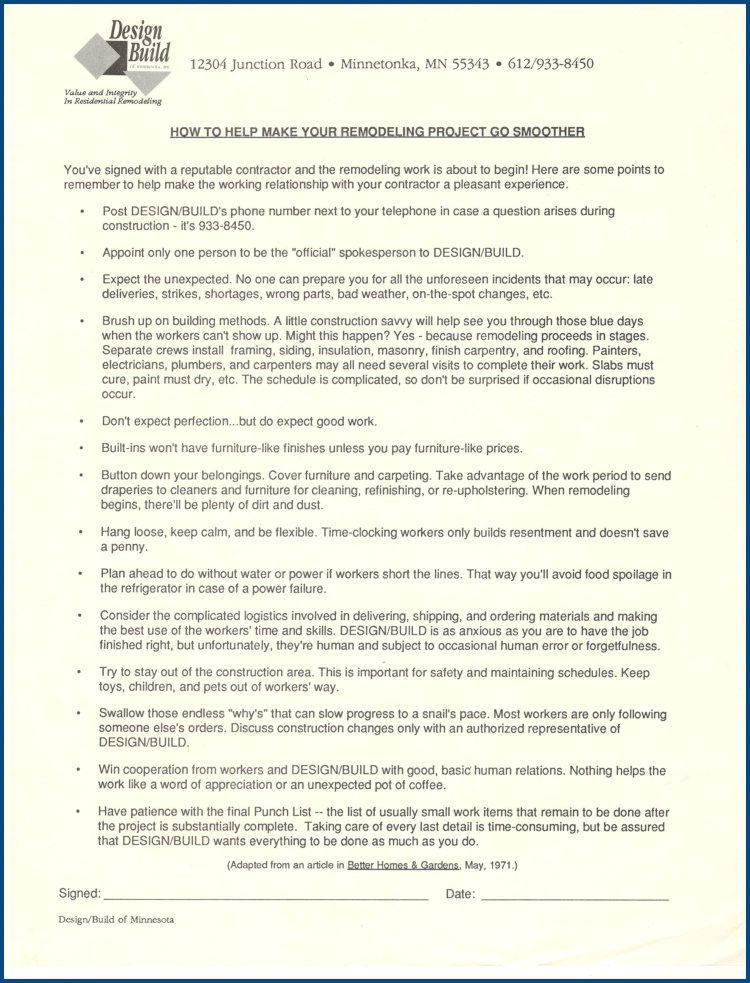Communication with your clients about all aspects of their remodeling project is always important. Letting them know what's coming will help put them at ease and make for a better experience for everyone.
Back in my remodeling days, when signing the project agreement I would always include an extra form that would be reviewed with my clients. We would review a bunch of items about things that could go wrong with their project.
The items listed below were on the form I used when I was a remodeling contractor. It has been updated and a few things have been added.
Give it a try in your business and add this information to your contract signing or pre-construction meeting. Be sure your clients sign the form.
-----------------------------------
HOW TO HELP MAKE YOUR REMODELING PROJECT GO SMOOTHER
You’ve signed with a reputable contractor and the remodeling work is about to begin! Here are some points to remember to help make the working relationship with your contractor a pleasant experience.
- Put [BUSINESS NAME]’s phone number into your cell phone in case a question arises during construction.
- Appoint only one person to be the official spokesperson to [BUSINESS NAME].
- Expect the unexpected. No one can prepare you for all the unforeseen incidents that may occur, such as late deliveries, strikes, shortages, wrong parts, bad weather, on-the-spot changes, etc.
- Brush up on building methods. A little construction savvy will help see you through those blue days when the workers can’t show up. Might this happen? Yes – because remodeling projects proceed in stages. Separate crews install framing, sliding, insulation, masonry, finish carpentry, and roofing. Painters, electricians, plumbers, and carpenters may all need several different visits to complete their work. Slabs must cure, paint must dry, etc. The schedule is complicated, so don’t be surprised if occasional disruptions occur.
- Don’t expect perfection, but do expect good work.
- Built-ins won’t have furniture-like finishes unless you pay furniture-like prices.
- Button-down your belongings. Cover furniture and carpeting. Take advantage of the work period to send draperies to cleaners and furniture for cleaning, refinishing, or reupholstering. When remodeling begins, there will be plenty of dirt and dust.
- Keep calm and be flexible. Time-clocking workers only builds resentment and doesn’t save a penny.
- Plan ahead to do without water or power if workers short the lines. That way you’ll avoid food spoilage in the refrigerator in case of a power failure.
- Consider the complicated logistics involved in delivering, shipping, and ordering materials and making the best use of the workers’ time and skills. [BUSINESS NAME] is as anxious as you are to have the job finished right, but unfortunately, they are still human and subject to occasional human error and forgetfulness.
- Try to stay out of the construction area. This is important for safety and maintaining schedules. Keep toys, children, and pets out of workers’ way.
- Bite your tongue when you’re tempted to ask “why” when you see a process you don’t fully understand. This can slow the progress down to a snail’s pace. Most workers are only following someone else’s orders. Discuss construction changes only with an authorized representative of [BUSINESS NAME].
- Win cooperation from workers and [BUSINESS NAME] with good, basic human relations. Nothing helps the work like a kind word of appreciation or an unexpected pot of coffee.
- Have patience with the final punch list, which is the list of usually small work items that remain to be done after the project is substantially complete. Taking care of every last detail is time-consuming, but rest assured that [BUSINESS NAME] wants everything to be done as much as you do.
- Remodeling fever will most likely happen during your project. This happens as your project progresses and things seem like they are slowing down. We will do our best to keep you informed about all phases of your project throughout the entire process.
(Adapted from an article in Better Homes & Gardens, 1971)
-----------------------------------
Here is the form I used in my remodeling business back in the day. It was a 3-part form that my clients were required to sign. If my clients would get upset during the construction process I would defuse many complaints by reminding them that this issue was on the form and we had discussed this before the project started.

I found that giving my clients the facts about what can go wrong on their projects really helped to put them at ease.
I also made it clear that we understand that stuff happens and that they have hired a company that will take great care of them, even when things go wrong.
Good communication includes telling the good and the bad of a construction project!
Go Get Em,
Dan Baumann, Chief Experts Academy
PS. Do you have some items you would like to add to this list? Leave your comments below and let me know what you tell your clients.



